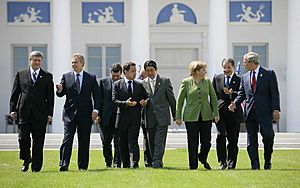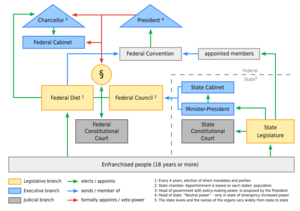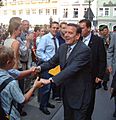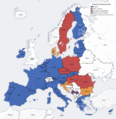Politics of Germany facts for kids
The politics of Germany are based on a federal parliamentary democratic republic. This means the country is made up of different states, and the government is chosen by the people through elections. Everyone has an equal vote. Germany's rulebook, or constitution, is called the Grundgesetz. It explains the rights of the people and the jobs of the President, the Cabinet, the Bundestag, Bundesrat, and the Courts.
The President is the head of state, but their role is mostly ceremonial. The Federal Chancellor is the real head of government. The Chancellor leads the main group in the legislature (the law-making body), which is called the Bundestag. The government, led by the Chancellor, handles the daily running of the country. Laws are made by the government and the two parts of parliament: the Bundestag and the Bundesrat. Government ministers are part of parliament and need its support to stay in power.
From 1949 to 1990, the main political parties were the Social Democratic Party of Germany (SPD) and the Christian Democratic Union (CDU), along with its partner party, the Christian Social Union of Bavaria (CSU). After Germany became one country again in 1990, the Green Party became more important. It was even part of the government from 1999 to 2005. Other important parties include Die Linke, which formed from parties in East and West Germany.
Germany is a federal country, meaning power is shared. A lot of government work is done by the 16 states (called Länder). The national government cannot get rid of the state governments.
Contents
Rights and the Constitution
Germany's political system is set out in its 1949 constitution, the Grundgesetz (Basic Law). This constitution continued to be used after Germany reunited in 1990.
The constitution puts human rights and freedom first. It also divides power. Power is split between the federal (national) and state governments. It's also split between the legislative (law-making), executive (government), and judicial (courts) parts of government. The 1949 Grundgesetz was written to fix problems from Germany's earlier government, the Weimar Republic. That government failed in 1933 and was replaced by the Third Reich dictatorship.
Federal Courts
The courts of Germany are independent. This means they are separate from the government and the lawmakers. Senior judges are chosen by the Bundestag for a set period.
Federal Executive Branch
The Bundeskanzler (Federal Chancellor) leads the Bundesregierung (Federal Cabinet). This means the Chancellor is in charge of the government's daily work. The Chancellor is chosen by the Bundestag, Germany's parliament, and must report to it. Germany, like the United Kingdom, has a parliamentary system.
Constructive Vote of No Confidence
The Chancellor cannot be removed from office during their four-year term unless the Bundestag has already agreed on a new Chancellor. This rule is called a Constructive Vote of No Confidence (German: Konstruktives Misstrauensvotum). It was created to prevent what happened in the Weimar Republic. Back then, governments often lacked strong support. Small parties would vote against the government but couldn't agree on a new one.
The Chancellor is usually from the largest party in parliament. This party often forms a coalition government with one or more smaller parties to get enough votes. The Chancellor chooses a Vice-Chancellor, who is also a cabinet member, usually the Foreign Minister. In a coalition government, the Vice-Chancellor typically comes from the smaller party in the coalition.
The Federal Cabinet
The Chancellor is responsible for setting the main goals of the government. This means they decide the big ideas for what the government will do. To help achieve these goals, the Chancellor can change the federal ministries whenever needed. For example, in 2001, the Ministry of Agriculture was renamed the Ministry of Consumer Protection, Food and Agriculture. This change helped fight the "Mad Cow Disease" problem. Some tasks from other ministries were also moved to this new ministry.
The Civil service of Germany works under the cabinet to carry out government policies.
The Federal President
The duties of the Bundespräsident (Federal President) are mostly about representing the country and performing ceremonies. The Chancellor holds the real power.
The President is elected every five years by the Federal Assembly (Bundesversammlung). This assembly meets only to elect the President. Its members include all of the Bundestag members and an equal number of delegates from the states. These state delegates are chosen based on the results of state elections. In February 2017, Frank-Walter Steinmeier of the SPD was elected. The President is not directly elected by the people. This is to prevent the President from becoming too powerful, which was a problem in the Weimar Republic.
| Office | Name | Party | Since |
|---|---|---|---|
| President | Frank-Walter Steinmeier | --- 1) | 19 March 2017 |
| Chancellor | Angela Merkel | CDU | 22 November 2005 |
| Other government parties | SPD, CSU |
1) Although Mr. Steinmeier has been a member of the SPD, the German Basic Law says in Article 55 that the Federal President cannot hold another job, practice a profession, or be a member of any company. The Federal President has put his party membership on hold and does not belong to a political party during his time in office.
Federal Parliament
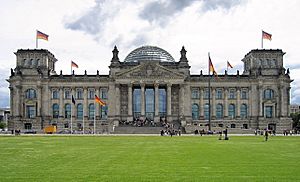
Germany has a bicameral legislature. This means its parliament has two houses. The Bundestag (Federal Diet) has at least 598 members, who are elected for a four-year term. Half of the members (299) are elected directly from local areas. The other 299 members are chosen from party lists across the states.
The total number of seats a party gets should match the percentage of votes it receives. This is called proportional representation. Because voters cast two votes (one for a local representative and one for a party), Germany has a mixed-member proportional representation system.
Sometimes, a party wins more local seats in a state than it should based on its overall vote percentage. When this happens, the party keeps those extra seats. This means the Bundestag can sometimes have more than 598 members. For example, in the current parliament, there are 16 extra seats, making a total of 614 members.
A party must get at least 5% of the national vote or win at least three local seats to be in the Bundestag. This rule, called the "five percent hurdle," stops many small parties from entering parliament. Many blamed small parties for the problems of the Weimar Republic's Reichstag.
The first Bundestag elections in West Germany were held on August 14, 1949. After reunification, the first all-German Bundestag elections were on December 2, 1990. The last election was on September 22, 2013. The 18th Bundestag met on October 22, 2013.
The Bundesrat (Federal Council) represents the state governments at the federal level. It has 69 members who are delegates from the 16 Bundesländer (states). Usually, the 16 Ministers President of the states are members. Each state has between three and six votes in the Bundesrat, depending on its population. Bundesrat members must vote as their state government tells them.
Powers of the Legislature
The legislature can make laws on its own (exclusive jurisdiction) or share law-making power with the Länder (concurrent jurisdiction). The Basic Law explains which laws can be made and by whom.
The Bundestag does most of the law-making.
The Bundesrat must agree to laws about money shared by the federal and state governments. It also must agree to laws that create more work for the states. This often means the Bundesrat needs to approve many laws, because federal laws are often carried out by state or local groups.
Because the political makeup of the Bundesrat is often different from the Bundestag, the Bundesrat is often where opposition parties express their views. This is sometimes more than just the states looking after their own interests, as the constitution intended.
If the Bundestag and Bundesrat cannot agree on a law, members from both groups form a Vermittlungsauschuss. This joint committee tries to find a solution.
Political Parties and Elections
The following parties were in the German Bundestag after the federal elections of 2013:
This made a total of 631 seats. The FDP lost all its seats in that election. The Alternative for Germany (AfD), the Pirate Party Germany, and the National Democratic Party of Germany (NPD) did not win any seats.
Bundesrat
The Federal Council is made up of representatives from the state governments.
| Political profile of State governments | Number | Notes |
| CDU/FDP | 18 | All of the votes of a state must be cast as a block. If the parties in a coalition do not agree how to vote then the Bundesrat can ignore that state's vote |
| CDU | 15 | |
| CDU/SPD | 12 | |
| SPD/CDU | 7 | |
| SPD/Left Party.PDS | 4 | |
| CSU | 6 | |
| SPD | 4 | |
| SPD/Bündnis 90/Die Grünen | 3 | |
| Total | 69 |
Judicial Branch
Germany has had a court system that is free from government control for a long time, even before it became a democracy. This means the courts have always been strong. Almost all government actions can be reviewed by the courts.
Organization
There is a system of "ordinary" courts that handle civil and criminal cases. This system has four levels:
- Amtsgericht - local courts
- Landesgericht - state courts
- Oberlandesgericht - state appeals courts
- Bundesgerichtshof - the federal supreme court for criminal and civil cases
There are also special courts that deal with specific areas of law. These usually have a state court and state appeals court before reaching the federal supreme court for that area. The other federal supreme courts are:
- Bundesfinanzhof - for tax matters
- Bundesarbeitsgericht - for labor law
- Bundessozialgericht - for social security law
- Bundesverwaltungsgericht - for administrative law, including government rules not covered by other special courts.
Unlike the United States, most courts in Germany are state courts, except for the top-level supreme courts.
Bundesverfassungsgericht
Germany also has another supreme court, the Bundesverfassungsgericht (Federal Constitutional Court). The Grundgesetz says that anyone can complain to this court if their constitutional rights, especially human rights, have been violated by the government. They must first go through the regular court system.
The Bundesverfassungsgericht hears complaints about laws, court decisions, or government actions. Only a small number of these complaints are successful. Even so, the Court often makes the government and lawmakers unhappy. The judges say they do not care about what the government, the Bundestag, or the public thinks. All that matters is the constitution.
The Bundesverfassungsgericht is very popular with ordinary people because it protects them from government wrongdoing. Only this court can handle certain types of cases, like arguments between government bodies about their constitutional powers.
Only the Constitutional Court has the power to ban political parties if they go against the constitution. So far, it has only used this power twice. It outlawed the KPD (Communist Party of Germany) and the SRP (Socialist Reich Party, a group linked to the NSDAP). Both parties' ideas were against the constitution.
Recent Political Issues
"Red-Green" vs. Conservative-led Governments
In the 1998 election, the SPD wanted to lower high unemployment and bring new faces into government after 16 years of Helmut Kohl's leadership.
Gerhard Schröder of the SPD presented himself as a moderate candidate, similar to Britain's Tony Blair and America's Bill Clinton. The CDU/CSU focused on the economic success under Kohl's government and their experience in foreign policy.
However, the Kohl government was hurt by slower economic growth in eastern Germany. This meant the gap between the richer west and the poorer east grew. The election results allowed a "red-green" government of the SPD and Alliance '90/The Greens. This was the first time the Greens were part of a national government.
The new government faced some disagreements between different groups within the SPD. In March 1999, SPD chairman Oskar Lafontaine resigned after losing a power struggle against Schröder.
The next election for the Bundestag was on September 22, 2002. Gerhard Schröder led the SPD and Greens to a victory over the CDU/CSU, led by Edmund Stoiber. Many believe Schröder won because of his good handling of the 2002 European floods and his strong opposition to the USA's 2003 invasion of Iraq.
Conservative Comeback
In February 2003, elections in the states of Hesse and Lower Saxony were won by conservative parties. In Hesse, the CDU leader Roland Koch was re-elected. In Lower Saxony, the SPD leader Sigmar Gabriel lost, leading to a CDU/FDP government.
In April 2003, Chancellor Schröder announced major job market reforms, called Agenda 2010. These reforms included changes to unemployment benefits. Although these changes caused protests, they are now seen as helping Germany's economy improve and unemployment fall in 2006-2007.
The European elections on June 13, 2004, were a big defeat for the Social Democrats. They got their lowest result in a nationwide election since World War II. Voters were unhappy about high unemployment and cuts to social security. Many thought this election marked the beginning of the end for Schröder's government.
Rise of the Right
In September 2004, elections in Saarland, Brandenburg, and Saxony showed a rise in support for right-wing parties. In Saxony, the NPD got 9.2% of the vote, winning seats in the state parliament. The rise of these parties worried the main political groups.
German Federal Election 2005
On May 22, 2005, the SPD lost badly in North Rhine-Westphalia. The SPD chairman then announced that the Chancellor would call for early federal elections. This surprised everyone, as the SPD was not doing well in polls. The CDU then announced Angela Merkel as their candidate for Chancellor.
At first, it looked like the conservatives would win easily. But this changed closer to the election on September 18, 2005. The conservatives lost votes compared to 2002, getting only 35%. They failed to get enough votes for a "black-yellow" government of CDU/CSU and the FDP. The FDP did well, getting 10% of the votes. But the SPD and Greens also failed to get a majority. The SPD got 34%, and the Greens stayed at 8%. The Left Party alliance got 8.7% and entered the German Parliament. The NPD only got 1.6%.
The most likely outcome was a "grand coalition" between the conservatives (CDU/CSU) and the social democrats (SPD). The three smaller parties (FDP, Greens, and Left Party) would be in opposition. Both Gerhard Schröder and Angela Merkel claimed they had won the election and should be the next Chancellor.
On October 10, talks were held between leaders of the SPD, CDU/CSU. It was announced that the CDU/CSU and SPD would start formal talks to form a Grand Coalition, with Angela Merkel as the next German Chancellor.
Angela Merkel became the first woman, the first person from East Germany, and the first scientist to be Chancellor. She was also the youngest German Chancellor ever. On November 22, 2005, Angela Merkel was sworn in as Bundeskanzler by President Horst Köhler.
Related Pages
Images for kids
-
Gerhard Schröder in the 2002 elections
-
Joschka Fischer in the 2005 elections
-
Former chancellor: Angela Merkel of the Christian Democrats
-
Olaf Scholz, chancellor since 2021.
-
Frank-Walter Steinmeier was the Social Democrat candidate for chancellor in 2009 and president of Germany since 2017
-
Sigmar Gabriel: SPD chairman from 2009 to 2017, 2013–2017 Deputy to the Chancellor
-
Constitutional court in Karlsruhe
-
Germany is a member of the European Union and the Eurozone
-
Defence Ministers of the NATO member states in 2000, an organisation West Germany joined in 1955
See also
 In Spanish: Política de Alemania para niños
In Spanish: Política de Alemania para niños


